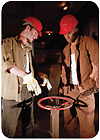
ANSI/AIHA Z10-2005 Occupational Health and Safety Management Systemshighlights the recommended hierarchy of controls to eliminate, reduce or control risks of different hazards. In order of effectiveness, the hierarchy of safety and health controls consists of elimination, substitution, engineering controls, warnings, administrative controls and personal protective equipment (PPE). Although PPE is typically defined as the last line of control, its use is often combined with other control strategies and is often essential to minimizing hazards.
Unfortunately, at times, PPE is not used effectively or as needed to minimize risks to health and safety. Factors contributing to this may include organizational, personal, behavioral and environmental factors. This article will focus on personal factors, with particular attention to knowledge and the perception of risk.
While PPE training is mandated by OSHA, it should be noted that OSHA regulations are minimal standards. Employers should strive to broaden their PPE training by incorporating theoretical concepts and methods of risk communication. Basic OSHA requirements for PPE training are instructional, but may not influence personal behavior or induce self-protective behavior.
Risk communication
Safety and health risk communication is the process by which people become informed about safety, health and environmental risks or hazards and are influenced to make informed judgments, decisions and behaviors. While safety and health risk communication is not a fix-all safety solution, it can be used to increase knowledge and awareness, influence perceptions and prompt action, and is, therefore, a tool that can be used to enhance safety training and educational messages. There are several theoretical concepts and methods in the risk communication field, as previously presented inISHNby experts such as Peter Sandman.
The mental models approach to risk communication is a theoretically integrated systematic approach to the design and dissemination of a risk communication. Theory supporting the approach is derived from mental model theory and textual design theory. The ultimate purpose is to elucidate mental models from individuals to ensure effective and proper communication message design. Mental models are thoughts, preconceptions and beliefs that exist within individuals.
Five steps to follow
The mental models approach is based on a five-phase process:
1) Develop an expert model:This is conducted to identify knowledgeable and credible sources and to ensure that technically all aspects of the hazard are presented.
2) Conduct mental model interviews:Interviews are conducted with laypersons to identify knowledge regarding a hazard, to identify knowledge gaps, to identify beliefs and to identify misconceptions.
3) Structured interviews:Structured interviews are conducted with persons, combining the information gained from the expert model and from the mental model interviews. Typically, questionnaires are established and provided. The information garnered from the questionnaires will provide direction as to how to design the risk communication message. The message is a combination of essential expert model information and information from the laypersons.
4) Draft communication:The next stage of the approach is the design and drafting of a risk communication message. This is a consensus of the information deemed as important and essential from the expert model and information derived from the layperson mental model interviews. The draft communication needs to eliminate unnecessary technical information and needs to fill knowledge gaps and correct misconceptions that have been identified.
5) Evaluate:The next stage of the process is to evaluate the risk communication message. This is typically conducted through person-to-person interviews, in focus groups, through questionnaires, etc. The message is tailored until ready for dissemination without error, confusion, misconceptions, etc.
Theory constructs
As is illustrated in the approach, the model is a systematic process; however, the process is based upon theoretical constructs essential to mental models. There are three main constructs on which the model is based:
1) Recipients of risk communication need to be apprised of the exposure, effects and mitigation prior to making informed judgments and decisions.
2) Recipients’ beliefs and mental models impact how new messages are interpreted.
3) Message design needs to be based upon textual theoretical design and principles.
With regard to textual theory, this impacts the design and readability or cognition of the risk communication. Design theory is focused on a few categories, including the structure of the presentation and the readability of the message. The risk communication product should include headings, which will increase recall and knowledge of the message. A hierarchical knowledge is garnered and, therefore, the most significant and important details should be listed. Lastly, outlines presented prior to dissemination will increase recall and knowledge retention of the risk communication message.
Weighing the weaknesses
This approach to risk communication design does have some weaknesses and limitations. The process requires time and effort and is not feasible for use within crisis communication. There are also some theoretical weaknesses with this approach. The tool encompasses mental model theory and design theory, but does not take into full consideration who is presenting the information or risk message. Trust and credibility from the source of the communication are essential in order for the risk communication message to be successful.
Despite its limitations, the mental models method does provide a tool and approach to designing risk communication messages that can be used to enhance education and training. The tool allows for effective messaging as it incorporates both the expert model and layperson input and remedies misconceptions. Lastly, the method is both quantifiable and can be evaluated on an empirical basis. This provides justification for using the tool and provides a means to evaluate communication message effectiveness.